Today we are going back to 1934 to learn about the roads and the means of transport for our ancestors.
What’s more interesting, we have a chance to see them with the help of an American, who set out on a three months trip of interwar Poland in her Packard to “obtain, before it was too late, views of things that are characteristic today but may be gone tomorrow”.

L.A.B.’s Packard car. September 29, 1934
I invite you to read the extract below from “Polish Countrysides” by Louise Boyd. Ms. Boyd described her findings so well that I have just taken her words directly from her book. I find this sort of time-travel fascinating. It is especially interesting to me because Louise has covered a lot of the territory of present Ukraine and eastern Poland, where I am spending so much time doing our heritage tours and family research today. I can trace all the changes, as well as many things that are not really gone, as Louise supposed would happen. Moreover, it is a great chance to learn about our ancestors’ reality and I hope you like it too.
![8 miles northeast of Swozdziec [Gwoździec]. Peasants on highway. September 23, 1934](https://doroshheritagetours.com/wp-content/uploads/2020/04/6fmday4pczyppnhsmtd7ls2efdvsiik2.jpg)
“8 miles northeast of Swozdziec [Gwoździec]. Peasants on highway. September 23, 1934”
Please read Louise’s words, as she wrote them:
“THE ROADS OF POLAND
Poland is by no means motorized to the level of her neighbors on the north, west, and south. In 1935 there were. 0.7 motor cars per 1000 inhabitants in Poland as contrasted with 11.9 in Germany, 22.6 in Sweden, 7.4 in Czechoslovakia and 1.8 in Rumania. Between 1931 and 1936 the number of automobiles in the country decreased progressively from 38,800 to 24,700. Horses and wagons or carriages, and boats and rafts on the navigable waters, are the principal means of transportation and travel away from the railways. Bicycles are much used, also, and for no small part of the population, the only means for travel is on foot and the only means for transporting goods their own backs.
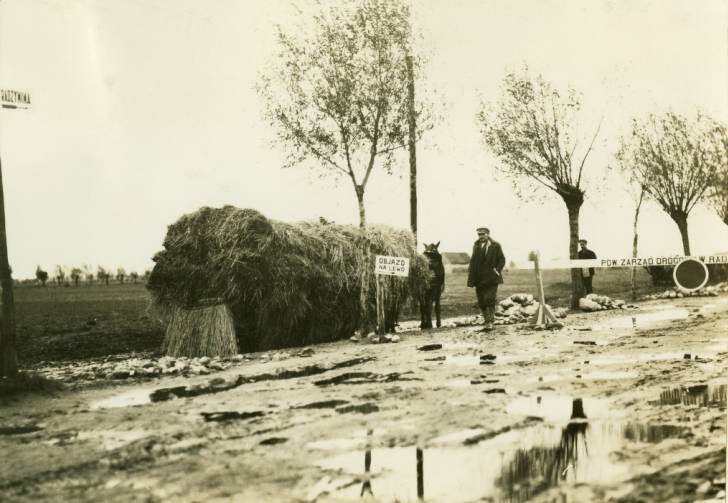
Detour, Warsaw-Wilno highway – 26 miles northwest of Warsaw. On left, hay wagon drawn by two horses. Road full of deep ruts which were full of water from the rain of the past few days. Oct. 10, 1934
It was like a return to conditions in the United States previous at least to 1906, to see a country where horses were the chief means of transportation on the roads and an automobile so rare in many areas as to be a curiosity. On market days horse-drawn vehicles, hundreds at a time, like great caravans, were to be seen on the way to and from the market towns, loaded not only with produce but with people as well, for market day is a day for the gathering together of the agricultural population. At the market place, friends meet friends, and market day is the next best thing to a fête day for most of the people.
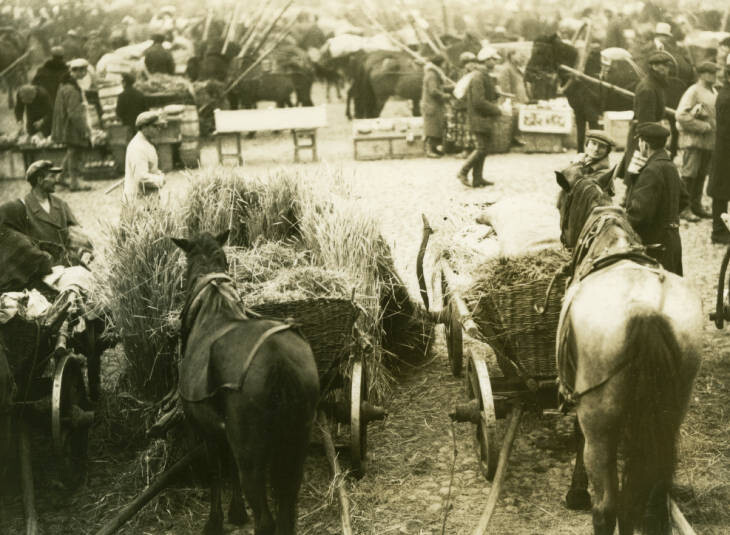
Pinsk monthly market. The hay section. October 3, 1934

Kielce. 116 miles south of Warsaw. 2.30 P.M. Market day. North entrance to town. Peasants on sidewalk with large white hog, returning from market. September 11, 1934
In various parts of Poland, I counted the number of vehicles and pedestrians that we passed along the road. The results of some of these counts are presented in the accompanying table.
Results of Traffic Counts Made in Different Parts of Poland

Legend:
a Warsaw-Gdynia highway north of Torun
b Commerical and army trucks included
c Warsaw-Krakow highway beginning 9 miles south of Warsaw
d Commercial trucks and public stages only
e Southeast of Kozieglowy
f From outskirts of Luck 29 miles south, villages excluded
g 1 autobus
h West of Bialystok
I West of Zambrow
j Between Baranowicze and Slonim (1 hour) and from the outskirts of Slonim west (15 min.)
k South of Kleck
l Between Rozana and Pruzana
m Northwest of Pruzna
n 1 automobile, 1 motorcycle
o Beginning 3 miles west of Lodz on road to Kalisz
p Includes 1 ox-wagon

Oxen on the road near Pinsk
It is believed that the counts are fairly representative samples, although, of course, it would be unsound to draw any conclusions on the basis of detailed comparisons of the figures, since the results are affected by accidental circumstances, such as day of the week, time of day, and place of count in relation to towns, etc. To facilitate broad comparisons, the numbers of horse-drawn vehicles, bicycles, and motor vehicles are expressed as percentages of the total number of vehicles. The scarcity of motor vehicles in all parts of the country is evident, as well as the relatively large number of bicycles in Pomerania, near Warsaw, and near the industrial centers of the southwest.
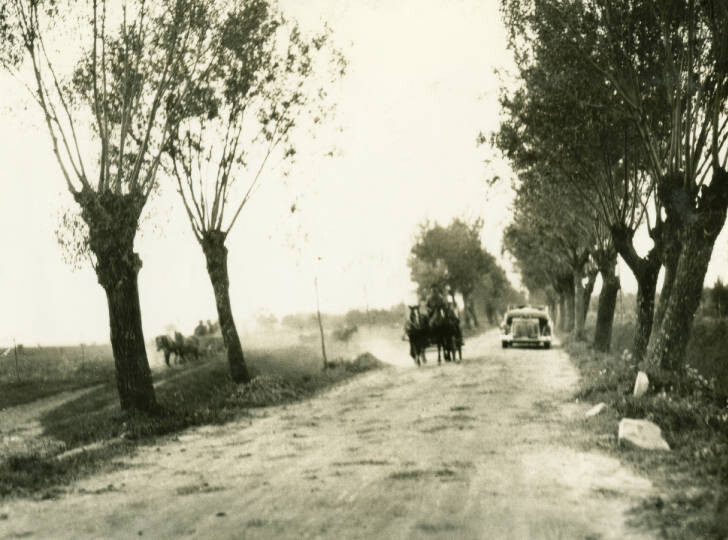
En route Dubno to Kowel. Two track highway with wagons on left and motors on right. Hard surface part of road was full of ruts. September 28, 1934
Lack of motor traffic is evidenced by the great fear of the horses on sight or sound of an automobile… Close to the large cities horses were motor-wise, but elsewhere it was the great exception when they were not afraid. Commonly, in spite of all the precautions we took, they would bolt from the road into the fields or jump suddenly across the road directly in front of us. Often there were long delays as we waited motionless for a long caravan to pass, and frequently our hearts were in our mouths for fear of a bad accident. Staring, gazing multitudes of people greeted us nearly everywhere. They often completely surrounded the car, necessitating the help of the police to clear a way for us.
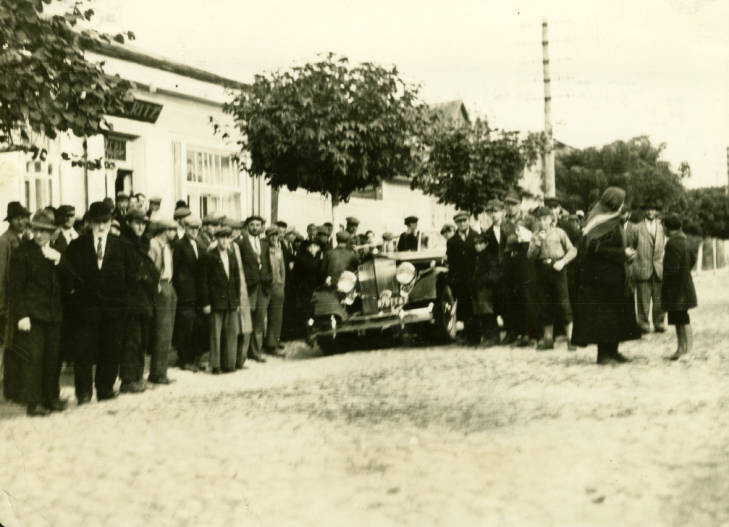
Kowel. Hotel Ritz, where we spent the night. In foreground, L.A.B’s Packard car arouses the curiousity of the town. September 29, 1934
Some sections of the main arterial highways are paved with concrete, asphalt, or brick and may be classed as first-class roads, but nowhere did we find a continuous first-class road connecting two important cities or connecting important cities with the highway systems of neighboring countries. At best, the first-class construction was completed only in part, and many delays and much slow travel resulted. Whereas in general the highways were of good width, most of them were dirt roads with a surfacing of hand-broken, very sharp rock, if they were surfaced at all. Even where the roads were surfaced, as much as two-thirds of the width of the highway was usually left as dirt for the benefit of the horse-drawn vehicles. Usually, even the surfaced roads were so full of ruts that it was impossible at best to travel at more than eighteen to twenty-five miles an hour, and for long stretches the maximum speed possible was much less than that. The ruts were sharp and extremely hard on tires, and the prevalence of horse-drawn vehicles was brought sharply to our attention by the horseshoe nails that a number of times punctured our tires. We had thirteen such punctures.
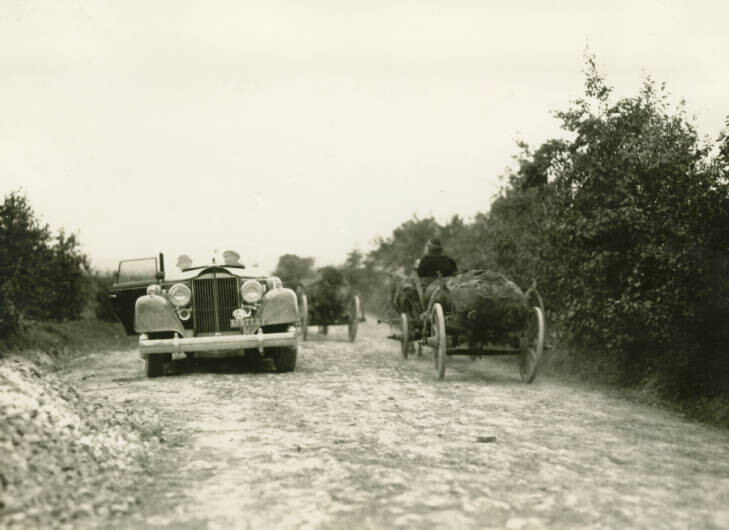
2 miles northwest of Nadworna. Barrels with petrol being taken from wells 14 km from here to refinery in Nadworna. On right, L.A.B.’s packard car. September 22, 1934
Many reasons were given me for the fact that, whereas Poland has made good progress in many directions since the establishment of the Republic, so little has been spent on highways. One was that it is the government’s present desire not to disturb too radically the existing peasant economy. There is much to be said for that. Extensive use of motors would mean that crops now grown to feed draft animals would have to be replaced by commercial crops for which a market would have to be found, and an increase in the domestic use of oil and gasoline would leave so much less of the country’s petroleum for export.

8 miles northeast of Gwozdziec. Peasant child on highway.
The Automobile Club of Poland issues road maps, but adequate coordination has not been made between maps and road signs. The lack of road signs, not only on secondary roads but even on the principal highways and particularly at crossroads, is probably the greatest drawback to a long motor trip in Poland. Such road and crossroad signs as exist are chiefly for the benefit of local transportation and give the names of and directions to near-by towns only, with no indication of the routes to the principal cities.

6.8 miles northeast of Horodenka. Settlement in ravine. September 23, 1934
Detours were so numerous as to deserve special mention. On these, without knowledge of the Polish language, one felt hopelessly lost. Road signs on these detours were rare, and many of the villages through which we passed were not to be found on any of the road maps available. Nowhere did I see a detour, even on so important a route as that between Warsaw and Poznań, with a sign indicating the principal city toward which it led. To obtain directions along the road was difficult even for our Polish friends who accompanied us; for most of those of whom we asked the way were persons whose horizons are limited by the distances that they themselves travel by horse and wagon or bicycle or on foot, and to whom the route to a principal city, if at all distant, is apt to be quite unknown.
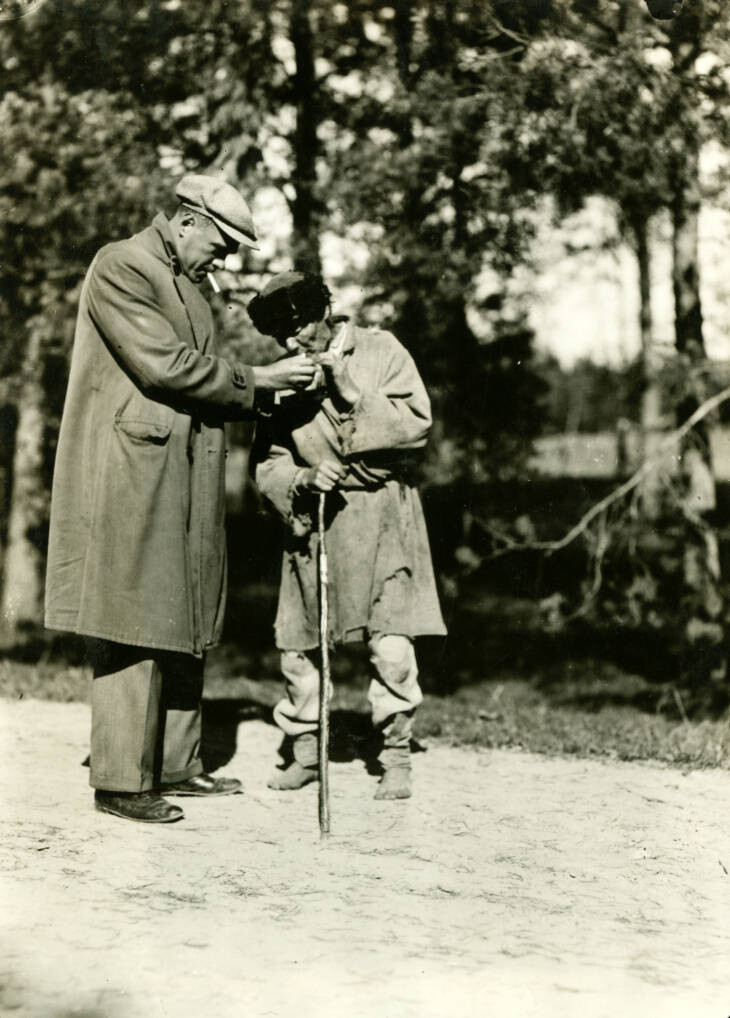
23.6 miles northwest of Ratno en route to Kobryn. 11.30 A.M. Giving a wayfarer a cigarette…September 29 1934
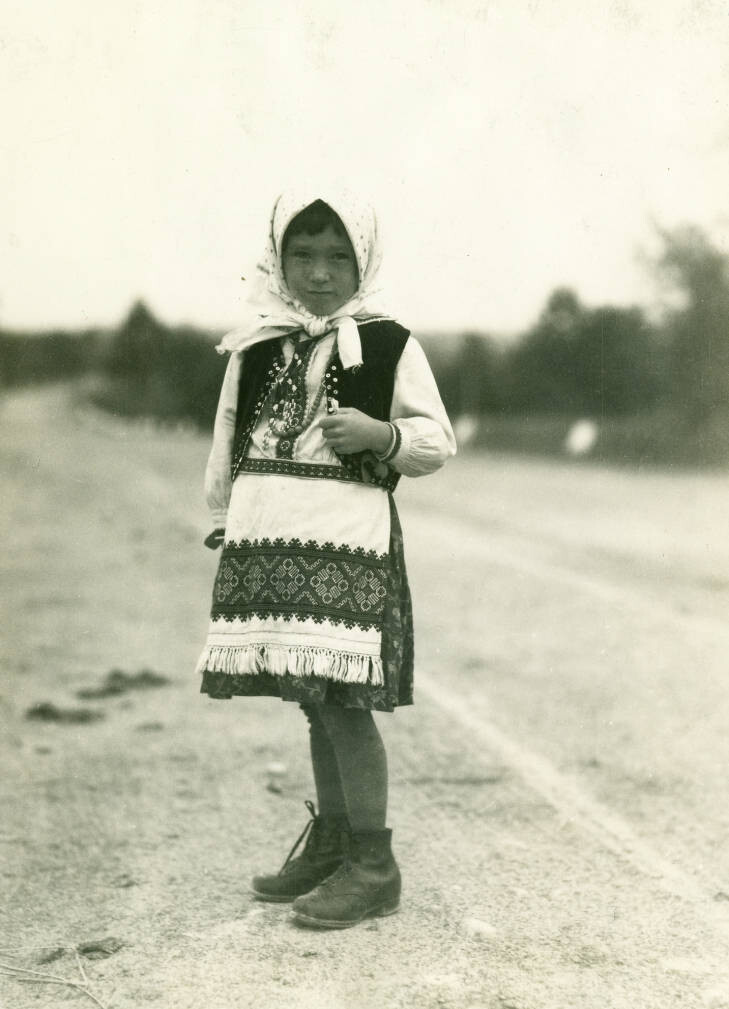
4.3 miles from Stryj en route to Dolina. Little Ruthenians (Hucul) girl on the highway. 2.30 PM. Typical costume. Velvet jacket beaded on edge, linen blouse and apron… September 21, 1934

En route Stryj to Dolina. Ruthenians on the highway returning from the market at Bolechaw. September 21, 1934
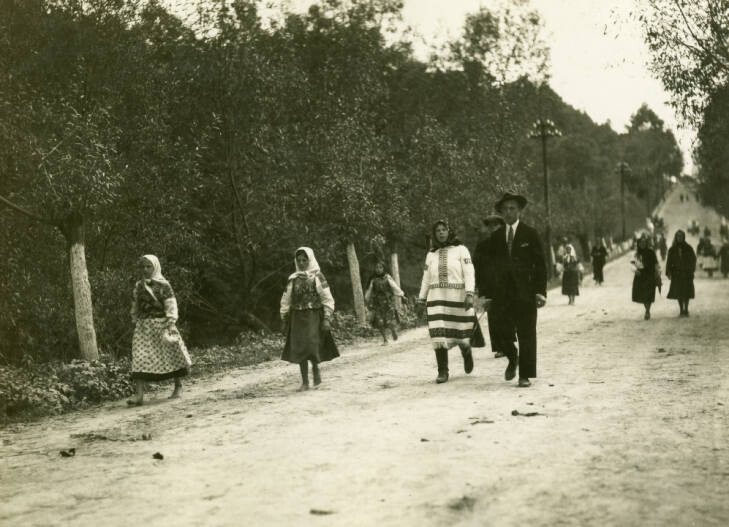
En route to Stryj to Dolina. Ruthenians on highway returning from market at Bolechow. On left woman in costume with bare legs and feet. Woman in center, in costume… September 21, 1934

14 miles southeast of Grodzisk. Woman leading cow hauling wagon load of branches for winter firewood. 12 noon. October 30, 1934

Ruthenians on the highway driving into Bolechow after church fete. September 21, 1934.
It must be said, however, that travel by automobile is possible nearly everywhere in Poland if one is willing patiently to accept delays and slowness of speed. In all, we covered 6300 miles within the boundaries of the country…
We had no difficulty in obtaining gasoline even in the remotest parts of the country, and, although it did not give so much power to our motor as we are accustomed to in the United States, it was of sufficiently good quality. The average price was the equivalent of 63 to 70 cents a gallon, and at one place we paid 80 cents.
Garage accommodations in the larger cities consisted of separate stalls in an enclosed yard, each housing one automobile and closed by a sliding door with a padlock, the key of which was given to the owner of the automobile. My automobile, being a Packard, was frequently found to be too long to permit the door to shut. Off the beaten track there were no garages, and the automobile had to be locked and left in a yard or on the road.
Gasoline stations usually consisted only of a small space with a pump. They had no facilities for repairing a tire, nor did they carry spare parts. Vulcanizing and patching of inner tubes could be done only in the larger cities, and we, therefore, carried a supply of extras with us. On entering the country I had four nearly new tires and two extras. When I left all were practically worn out. For any extensive motor travel in Poland, it is necessary to be supplied with good tires and spare parts and to be prepared to make one’s own repairs, except in the larger cities. Small tires suitable for Fords and similar automobiles and for the small European makes are more readily obtainable than the larger sizes.
Accommodations for overnight lodging differed greatly. In the larger cities, such as Warsaw, Kraków, ŁódŻ, Wilno, and Poznań, there are, of course, comfortable hotels where rooms with private baths are to be had. In all other cities, however, the hotels are small, ranging in height from one to possibly four stories. In the newer of them, there is running water in the rooms; but in most of them the pitcher and bowl are still in use, and in none of them is a private connecting bathroom to be had. Away from the main highways accommodations are very simple and often primitive. Mattresses are likely to be of gunny sack filled with straw. Frequently the bed linen is not clean, but clean linen may be had on demand.”
Source: Polish Countrysides. New York: American Geographical Society. 1937., pgs: 9-14
Dear friends, I invite you to follow Andriy Dorosh on FB not to miss our further publications. Check our genealogy research section if you would like to discover your family story. Have you thought about virtual travel? Looks like it is a good solution today. Sending wishes for health and wellness your way!